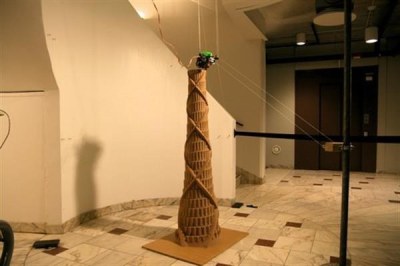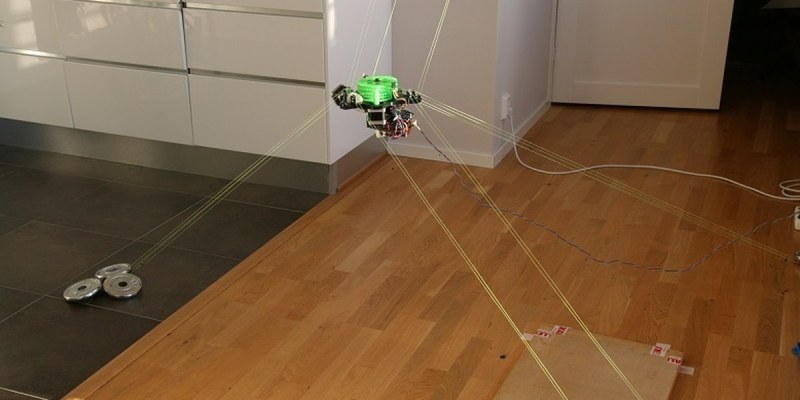There are many things people do with spare rooms. Some make guest rooms, others make baby rooms, while a few even make craft rooms. What do hackers do with spare rooms? Turn them into giant 3D printers of course.  [Torbjørn Ludvigsen] is a physics major out of Umea University in Sweden, and built the Hangprinter for only $250 in parts. It follows the RepRap tradition of being completely open source and made mostly from parts that it can print.
[Torbjørn Ludvigsen] is a physics major out of Umea University in Sweden, and built the Hangprinter for only $250 in parts. It follows the RepRap tradition of being completely open source and made mostly from parts that it can print.
The printer is fully functional, proven by printing a five-foot tall model of the Tower of Babel. [Torbjorn] hopes to improve the printer to allow it to print pieces of furniture and other larger household items.
[Torbjorn] hopes that 3D printing will not go down the same road that 2D printing went, where the printers are designed to break after so many prints. Open source is the key to stopping such machines from getting out there.
Thanks to [Jeremy Southard] for the tip!















I am 100% prepared to convert a spare bedroom into a 3D printer.
Do you have one ?
just not the one full of spare parts and unfinished projects :P
Be sure to tell your Wife though. You’ll be hearing screams across the house if caught unprepared. ;-)
I’d put spider legs on it and warn her about the dangerous, but endangered, arachnid. Gotta just lock the room and hope it eventually goes away. But look at that gorgeous web it spun!
I’d buy one!
I am almost 100% sure that this is a repost. I’m not upset about it showing up again – whomever did the last posting forgot to include it in the 3D Printer category. It may have originally been a HaD link or something.
Or I could just be totally senile. Does anyone happen to know where else this wonderful project has been featured recently?
Monoprice Select Mini Facebook Group
Any news on when the Select Mini V2 launches? Haven’t heard a peep since they said it was coming in April back in January.
I’ve seen it before too, though I can’t remember where.
“I am almost 100% sure that this is a repost.” If it’s any consolation, we feel that way all the time!
acrobotics?
acrobot?
very cool stuff.
Am I correct in that the maximum printable volume of this is roughly limited to the triangular prism formed by the anchor points?
Does he address rope stretch at all?
The volume is limited to a pyramid (or tetrahedron) with the four anchor points being the vertices.
Interesting concept. I bet you could limit it to one stepper if you made the gear shift into other axis gears using a solenoid or other electromechanical thingermabob.
Maybe if your gear shifter works in milliseconds…
The X and Y axis stepper motors need to move simultaneously for printing arcs and what not. If this device works in Cartesian coordinates you could very well do as you’re suggesting with one stepper working for either the X or Y – as well as the Z axis. Note that if this is the case, you would not be able to print in Spiral Vase mode; and that would be frustrating for a printer so big- since i’ts very likely going to spend its days making single walled large objects.
However, if this thing moves in delta coordinates, you’ll need to move all three steppers at the same time to make a move from point (0,0,1) to (0,0,5) even though it seems like just one stepper should be needed for such a movement. If that’s the case, then your idea wouldn’t work!
very true. At the very least a new software to map it down (think how easel software does it.) and the prints could very well be slow unless what you have pointed out could move the shifter in milliseconds.
no need for simultaneous movements. for arcs you could break it down linearly. then only move one axis at a time.
I would definitely use this in my garage!
This is looks like a very elegant design and it move elegantly too. If I only had a spare room and too much time…
Nice project! Rope stretch could be an issue of some sort, but for printing simple things like a lamp shade or a tower I sure that nobody will notice the error (or care), that is, if there is an error.
Instead of spare room or garage, I’m thinking attic… its a heated build space in the summer time!
I doubt you can get much accuracy out of such a setup, although perhaps one doesn’t care if printing giant things. I’d love to know, either at room size or even regular printer size, how the rope/cable vibration and tension (you need a lot of tension to span large distances and not have the print head sag) affect print quality.
You can actually do the math to compensate for cable sag quite easily. I was part of a project which used long lengths of carbon fiber for positioning. Rigidity/vibration is hard to work around though, maybe try to damp movement of the print-head with large “sails” to provide air resistance?
I think sufficiently complex control system could do a really good job, especially with some extra sensors and a calibration routine.
What about cable twist? Is that easy (apparently like sag) or hard (apparently like vibration). Although I would assume vibration would be predictable, and thus handleable. But what do I know? Any good sources I should look at?
I wonder if you could set up some kind of illuminated beacon on the print head, and use webcams at the rope attachment points to track where the print head actually is and autocorrect for that.
I was wondering about laserdisc sonic rangefinders.
Speaking of autocorrect. I call it autocorrupt.
What I typed was (ultra)sonic or laser rangefinders.
Oh! We proposed this very same idea in 2014:
http://www.hizook.com/blog/2014/07/15/stadium-sized-3d-printers-using-winch-robots-aka-cable-robots-or-rope-robots
The next obvious step was to make a 3D printer the size of a sports stadium!
It has been proposed since the 80’s. Back when 3D printers were known as Santa Claus machines. We re-purposed hotmelt glue and old pen plotters. Some teams experimented with it and posed the results on the old newsgroup board, but it always lacked the repeatability and resolution they were getting with rigid frames (high-tech at the time).
It’s the cheapest possible way to make a 3D printer. I hope it gets developed into an inexpensive product.
Would be nice if it had a cubic build volume like skycam and other winch/cable robots though.
Now let’s get steel cables and a concrete nozzle on this thing.
My neighbour’s dog had the same idea about my front lawn. Not sure what he is printing but I catch him every morning adding to it.
Sounds more useful than the usual 3D printed lampshade.
Because it was built by a hobbyist. And it’s awesome.
Is he using a “universal paste extruder” ? :P
I will be building a new shed now…. Just so I can have a space to use this in!
quick observation, I like what you’ve done with anchoring the xy-motion. But I’m afraid that without something more permanent it may not remain accurate over large builds. Thoughts?
Also, I’ve been playing with the same idea… I want to print big, but for cheap. So I’ve flipped a desk upside down and have been building that into a printer. You might be able to do something similar here.
Particularly interesting are the CAD “programs” from the project repo – great demonstration of the power of OpenScad and parametric CAD in general!
One problem: doors.
A garage, warehouse or even a walk in closet could work for this, because the doors can accomodate the cubic feet the room has to offer.
However a spare bedroom is a bad idea. since its a fairly large room with only a normal sized door.
No matter how big the room is, you’d still be limited to the size of the doorway, unless you plan on keeping that object in that room. ( Though, in my opinion, whats the point of “printing big” if you can’t even get it out of the room).
If you’re printing something that large just move the printer to the final destination for the object and build it there.
I wonder if it could be made to use a chain instead of line. in my limited understanding of 3d printers, that would seem to have advantages. Links are printable, less stretch, could be made to be more sway risistant.